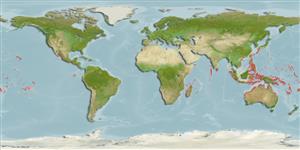Actinopterígios (peces con aletas radiadas) >
Perciformes (Perch-likes) >
Gobiidae (Gobies) > Gobionellinae
Etymology: Stenogobius: Greek, stenos = narrow + Latin, gobius = gudgeon (Ref. 45335).
Medioambiente / Clima / Gama
Ecología
; marino; agua dulce; salobre demersal; anfidromo (Ref. 51037). Tropical, preferred ?
Indo-West Pacific: east African coast and offshore islands to Indonesia and western Pacific. Reported from French Polynesia (Ref. 12792).
Tamaño / Peso / Age
Maturity: Lm ? range ? - ? cm
Max length : 18.0 cm SL macho / no sexado; (Ref. 12693)
Espinas dorsales (total): 7; Radios blandos dorsales (total): 10-11; Espinas anales 1; Radios blandos anales: 10 - 12. Scales on predorsal midline 13-20, usually 15-18; scales in horizontal series 46 to 51, usually 48-49; breast scaled; belly anteriorly with small naked patch next to pelvic base (Ref. 34009).
Occurs inshore (Ref. 4343) and enters brackish and fresh water along the upper tidal zone of rivers (Ref. 12693). Larvae spend time in the marine zooplankton and as juveniles, about 135 days old, recruit to freshwater streams where they undergo rapid growth and morphological changes neceassary for upstream migration to the adult habitat (Ref. 51037). Marketed fresh in mixed catches (Ref. 12693).
Life cycle and mating behavior
Madurez | Reproducción | Puesta | Huevos | Fecundidad | Larva
Benthic spawner.
Watson, R.E., 1991. A provisional review of the genus Stenogobius with descriptions of a new subgenus and thirteen new species (Pisces: Teleostei: Gobiidae). Rec. West. Aust. Mus. 15(3):627-710. (Ref. 34009)
IUCN Red List Status (Ref. 115185)
CITES (Ref. 94142)
Not Evaluated
Threat to humans
Harmless
Human uses
Más información
ReferenciasAcuiculturaPerfil de acuiculturaRazasGenéticaFrecuencias de alelosheritabilidadEnfermedadesProcesamientoMass conversion
Herramientas
Special reports
Download XML
Fuentes de Internet
